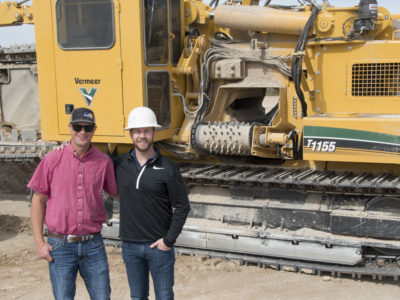The rippling current of the 2008 U.S. housing market collapse struck more than just new home construction in cities like Phoenix, Arizona. It halted planned infrastructure improvements, and the combination proved fatal to many companies whose livelihood depended on the two sectors.
A decade later, the Phoenix-area community of Goodyear is booming again. Contractors whose businesses survived the recession are now facing a different challenge: The wall of work that is leaving many scrambling to keep up.
Sellers and Sons, Inc. was one of the general contractors that made it through those challenging years, though it took consolidation and restructuring to make it work for the family business with locations in Tucson and Phoenix, Arizona.
“Before the housing bubble, Sellers and Sons was primarily known as a local family-owned business that specialized in installing outdoor sports lighting and building HUD housing for American Indian tribes in Arizona,” said Spencer Sellers, who was working in underground utility line installation prior to joining Sellers and Sons. Today, the company that once just handled construction has diversified into underground utility work.
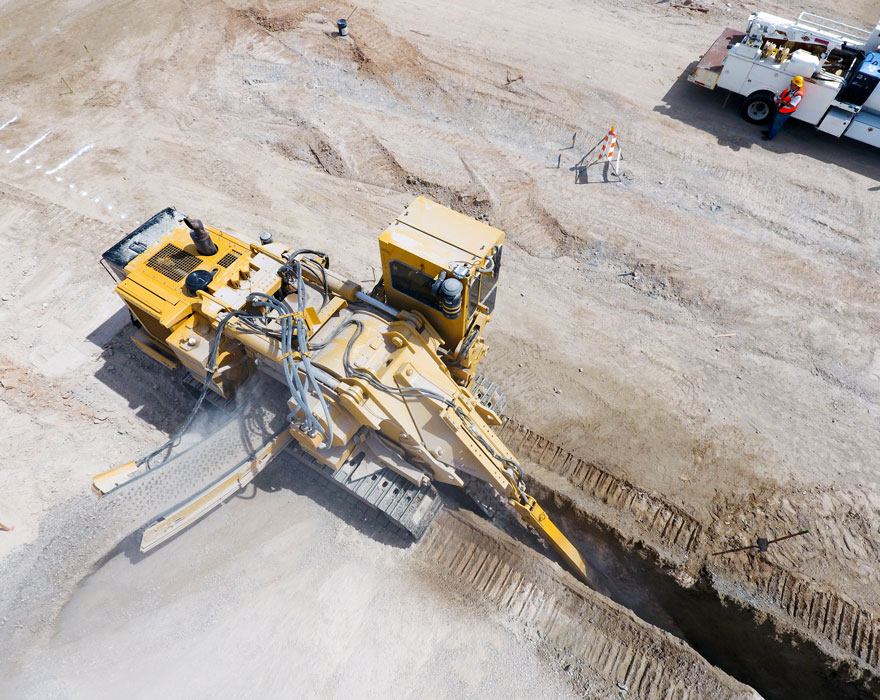
Estrella water project
That diversification sent Sellers and Sons in new directions, including the installation of water lines for Goodyear’s largest new planned community, Estrella. At just over 20,000 acres (80 km sq), Estrella is located in the foothills of the Sierra Estrella Mountains in the Sonoran Desert Valley. The affluent community currently has just over 14,000 residents but is forecasted to grow significantly in coming years.
To prepare for that growth, Sellers and Sons is installing 3,900 feet (1,188 m) of 16-inch (40.6 cm) diameter ductile iron water pipe alongside the major thoroughfare Estrella Parkway, which adjoins areas where residential subdivisions will be built. The new line is being installed at depths of up to 16 feet (4.9 m) deep. The crew is also running a shallower trench parallel to the water line ditch for a future electrical line.
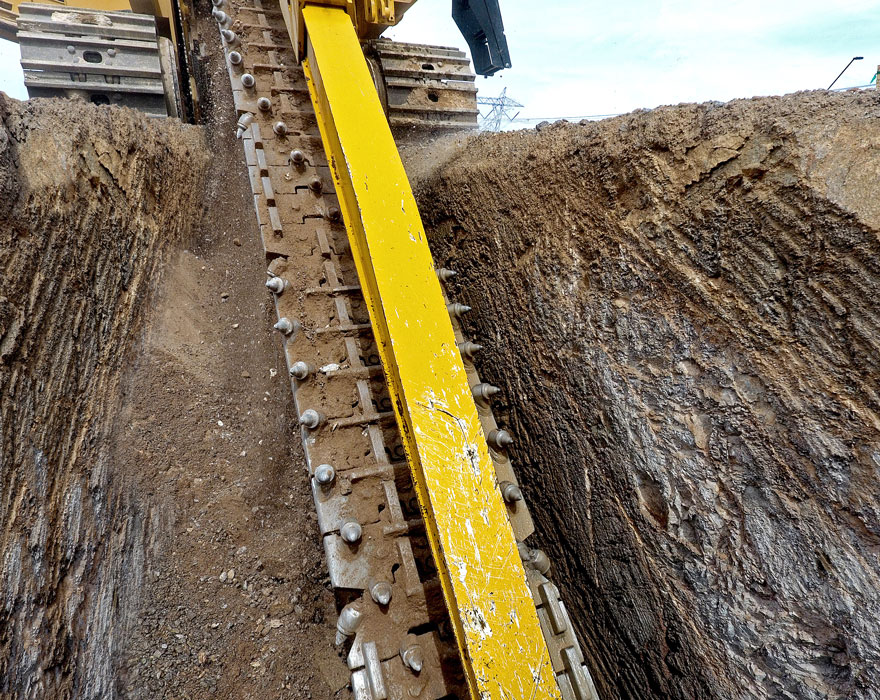
Planning for rock
Projects like the Estrella parkway come with unique challenges, namely frequent encounters with underground rock formations. It’s so common in this area that underground contractors often include “rock clauses” in contracts that cover potential additional labor costs when facing unexpected granite and other rock formations while digging.
“We’ve done a lot of work in the area, usually with excavators, and knew we would be digging in a mixture of granite and dense blue granite,” Sellers said. “In those conditions, a person’s lucky if he or she can dig 200 feet (61 m) in two weeks with excavators and hammers. It’s a real challenge and hard on equipment.”
Sellers and Sons’ site foreman Baron Holly recognized this challenge and the limitations it would place on his crew’s work and equipment. His first step toward a solution was to call Vermeer Sales Southwest, Inc. to inquire about a rock trencher.
“We’ve rented trenchers from this Vermeer dealer in the past, but this project was going to be a lot more challenging because it was entirely in rock,” Holly said. “The team at Vermeer Sales Southwest did more than rent a trencher to us; they pulled samples of the rock we would be digging in, sent it off to be analyzed, and then came back with an equipment recommendation to help maximize productivity.”
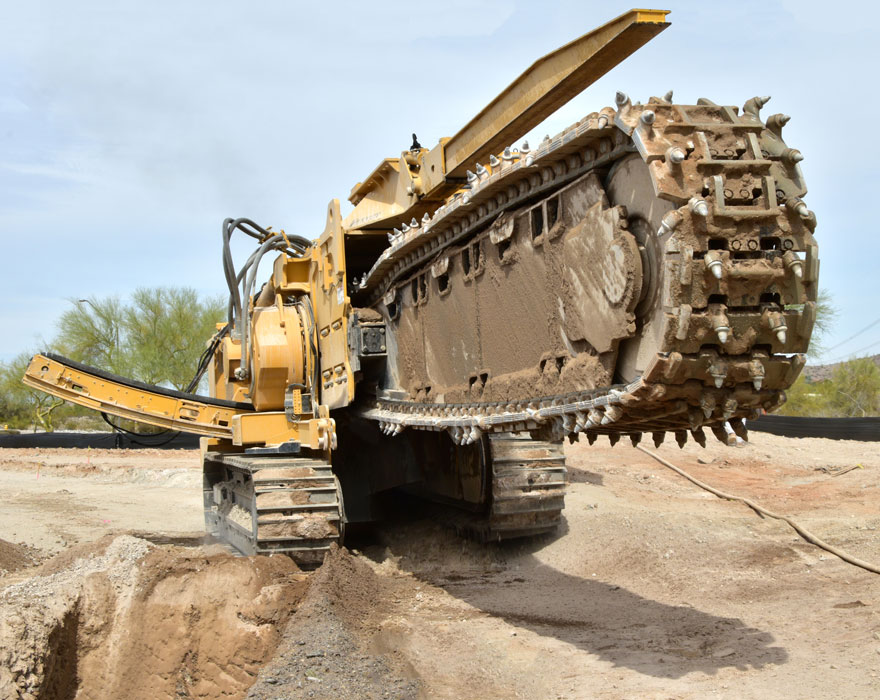
Collaboration with testing
Sellers and Sons’ Vermeer dealer sales representative, Justin Siler, sent the core samples from the Arizona jobsite to the Vermeer Corporation rock lab in Pella, Iowa, for extensive testing. Afterward, Siler supplied Sellers and Holly with a rock lab report that provided data on the rock’s hardness, abrasiveness and how it may respond when workers and machines encountered it.
“With that information, we were able to help them calculate estimated production rates and operating costs,” Siler said. “From there, we recommended the Vermeer T1155 Commander® 3 trencher with Kennametal RockRazorTM TS19C “X” cutting teeth to perform in the rocky ground conditions.”
Impressive results
Sellers and Sons quickly saw results. Using the recommended equipment, they were able to trench between 600 and 800 feet (182 – 244 m) per day. With a 540-horsepower (402.7 kw) engine, the Vermeer trencher worked through both granite and blue granite formations at an aggressive pace.
Alongside the 16-foot (4.9 m) deep, 34-inch (86.3 cm) wide trench, the crew dug an offset trench for the electrical conduit. Initially, Sellers and Sons thought they would have to change out the boom for the shallow area, but rock toward the surface was soft enough they could still productively trench at those depths with the longer boom.
“We wanted the boom on the trencher between 45 degrees and 90 degrees when trenching in hard rock like this,” explained Sellers. “If we tried to run too flat then the boom could have bounced a bit. However, since the top three to five feet were softer, we didn’t have to change the boom out.”
Sellers and Sons completed trenching on the Goodyear, Arizona, project in just over two weeks – a timeframe that impressed the customer, crew and other contractors working nearby. “A few years ago, we did a project in the area similar to this one, but we weren’t dealing with as much rock,” Sellers said. “It took us two weeks to get those 200 feet (61 m) with an excavator and hammer; the same amount of time we spent trenching on the whole Estrella job!”
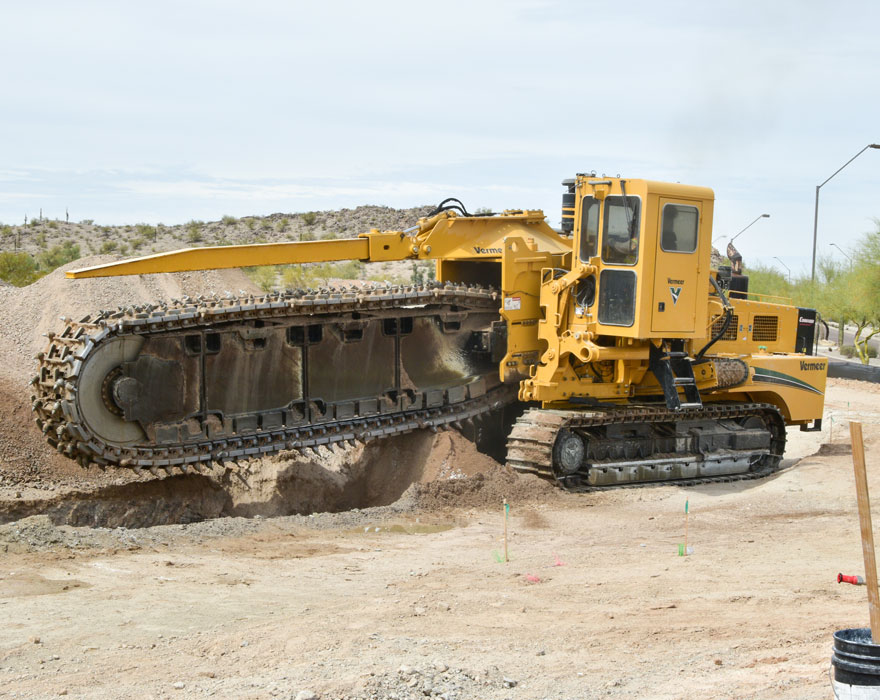
Growing demand
One of the people to notice how quickly the Sellers and Sons crew wrapped up the Estrella Parkway job was a contractor and friend of Sellers and Holly dealing with his own rocky nightmare on a nearby project.
“Our friend’s crew was working right next door at the Rosewood Golf Villas community,” mentioned Sellers. “In the time it took to complete our project, they were only able to dig around 200 feet (61 m) with an excavator. They weren’t happy, and the customer was getting concerned about the growing costs involved with installing this new waterline.”
Their friend asked if Sellers and Holly could bring the Vermeer T1155III trencher over to their job when they were done. This job has similar ground conditions, trench depths and the need for a parallel trench. The only difference was the size of the waterline, as it was smaller.
“We are just starting this job, but we expect similar productivity,” said Sellers. “The Vermeer trencher and our crew will be able to efficiently complete the project, and that’s a big deal for everyone.”
Looking ahead, Sellers said he sees the T1155III trencher as a means through which his company can reach a new area of work that it couldn’t before. And, not only is the machine opening new doors, it’s doing so efficiently.
“We have two more jobs in the works once we’re done with this. We rented the T1155III trencher for one job, and now I’m not sure how long we will continue to rent it,” Sellers said. “I think the whole area is growing and the area developers want to make sure they have the necessary infrastructure in place to keep up.”
This article contains third-party observations, advice or experiences that do not necessarily reflect the opinions of Vermeer Corporation, its affiliates or its dealers. Testimonials and/or endorsements by contractors in specific circumstances may not be representative of normal circumstances experienced by all customers.
Vermeer, the Vermeer logo and Commander are trademarks of Vermeer Manufacturing Company in the U.S. and/or other countries. Kennametal and RockRazor are trademarks of Kennametal, Inc.
© 2018 Vermeer Corporation. All Rights Reserved.
